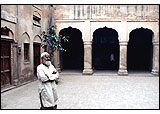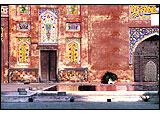 |
The
Remains of a Haveli
Garden in Lahore
|
 |
|
|
|
|
 |
|
|
|
 |
The walled
city has changed as dramatically as the suburbs of Lahore since
Mughal times. When Akbar rebuilt the walls of the city in the
sixteenth century, it is likely that he extended them to include
areas less densely settled in the eastern part of the city (Lahore
Development Authority, 1982; Dar, 1993; Quraeshi, 1988). And those
areas may have had gardens. Subsequent development and redevelopment
have obscured the open spaces and Mughal period gardens of the
walled city and its immediate surroundings. We have little more
than textual references to haveli gardens, which, it should
be noted, represent a distinct residential garden type with interior
courtyard wells, vines, and potted plants.
|
 |
|
|

Following the processional approach, it is useful to begin at a
spot just outside the city walls, near the Delhi gate, and to move
in towards the center of the Mughal city. The suburbs immediately
east of Delhi Gate had Mughal gardens built from the time of Mirza
(Prince) Kamran in the early sixteenth century to that of Prince
Dara Shikoh in the mid-seventeenth century. Kamran probably built
his earliest gardens in the Naulakha area, just east of the walled
city; the area was later extensively developed by Asaf Khan and
expanded by Dara Shikoh, from whom a part of it acquired the name
Mohalla Dara Shikoh (Parihar, 1984). Although it is well known that
many structures were torn down for bricks, the remains of at least
one Mughal hammam (bath) remain below ground in Mohalla Dara
Shikoh.
 |
|
|

Delhi gate was rebuilt by the British and restored again in the
1990s, as were the Mughal baths just inside the gate. As was common
in Mughal town planning, baths figured prominently immediately within
and outside the city walls. A narrow lane of shops line the bazaar
from Delhi gate to the chowk (crossing) of Wazir Khan's mosque
(built in 1634). Although no gardens are recorded along this particular
path, some were recorded in nearby havelis. Haveli Mian Khan near
Rang Mahal, for example, had extensive courtyards and fountains.
It also allegedly had an underground tunnel connecting it to the
fort.
 |
Detail
from the
Wazir Khan Mosque
|
|
|
|
|
|
Wazir
Khan's Mosque
|
 |
|
|
|
Proceeding
above ground from Wazir Khan's mosque toward the fort, there are
two old Mughal period havelis that had large garden courtyards
in the Chuna Mandi area. These havelis have a long record of modification
from Sikh times to the 1990s, the most recent restoration being
completed in 1993. A new garden has been added in front of the
main haveli, but no excavations have been made in either of the
interior garden courtyards. There is some speculation that these
havelis belonged to Asaf Khan, but no concrete evidence has been
produced to date.
|
|
|

Just beyond
the Chuna Mandi haveli is the mosque of Maryam Zamani, also known
as the Begum Shahi mosque. Maryam Zamani was the sister of Raja
Bhagwan Das and the mother of the fourth Mughal ruler, Jahangir.
Her mosque, completed in 1614, is the oldest surviving mosque of
the Mughal period in Lahore. It is compared with paradise in an
inscription on its northern gateway (Latif, 1892, 131). Like other
Mughal mosques in Lahore, it has no garden courtyard, but it does
have fine floral fresco decorations that remind one of the vegetal
imagery associated with paradise and paradise gardens.

These days, shoe shops block one's view back up the hill toward
the haveli gardens, and iron wheel shops block one's view in the
opposite direction to the Masti (Masjidi) gate on the east side
of Lahore Fort. A few trees remain in haveli and mosque courtyards,
but the principal garden remnants now lie either outside the walled
city or within Lahore Fort. |
 |
 |
 |
 |
|